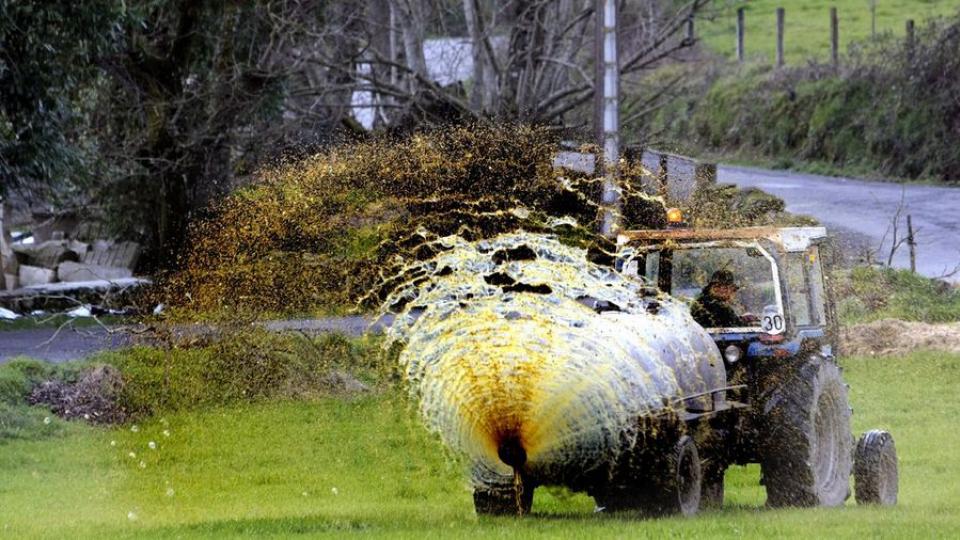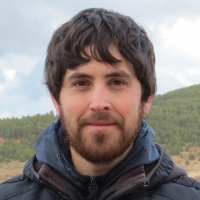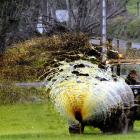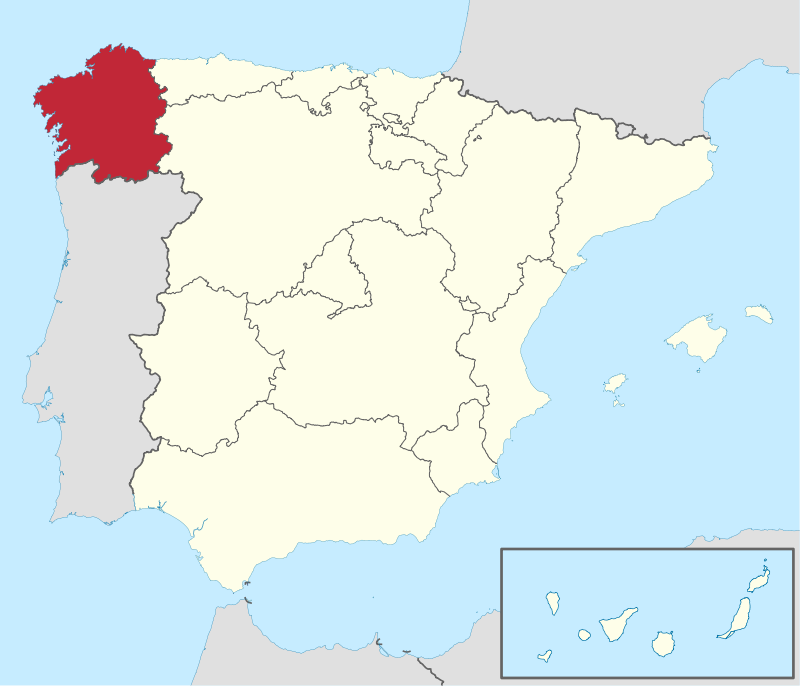
The location of Galicia.
The location of Galicia.
Image created by TUBS.
Click here to view Wikimedia source.
 This work is licensed under a Creative Commons Attribution-ShareAlike 3.0 Unported License.
This work is licensed under a Creative Commons Attribution-ShareAlike 3.0 Unported License.
In November 2017, the Spanish government published a Royal Decree (RD 980/2017) which required technological change to ensure that Spanish farmers were compliant with EU environmental regulations, a prerequisite for receiving grants through the EU’s Common Agricultural Policy (CAP). While the decree looked like a good way of implementing sustainable approaches in Spanish agriculture, it marked the beginning of a conflict that still endures today over the future of farming in Galicia in northwestern Spain, where farmers’ organizations fear that the well-being of Galicia will be sacrificed to a political trend that is deeply at odds with local realities.
Historically, the agricultural industrialization paradigm strongly influenced technological change in Spanish agriculture, beginning in the 1950s and continuing during the following decades. The slogans that determined technological choices during this period were based on absolute trust in fossil-fuel-based technologies. Thus, Galician agriculture—characterized by sufficient rainfall, mild winter temperatures, and soils good enough to provide satisfactory yields—became highly specialized in industrial dairy-cattle farms. Expensive tractors and slurry tanks were introduced and investments were made in new facilities that ran on electricity and used intensive cattle feed and fertilizers. All those changes were introduced in a densely populated region and served to fragment farmland, which were and continue to be major drawbacks.
However, since the end of the twentieth century, technological change has paid more attention to environmental sustainability criteria, as the European Union has proclaimed the need for alternative models of agricultural development. In May 2018, the Spanish government published another Royal Decree (RD 294/2017) that was meant to promote the Renewal Plan for Agricultural Machinery. Farmers had to introduce new injection systems or hanging tubes for the application of slurry in order to reduce ammonia emissions. Nevertheless, this policy was in striking conflict with the most popular application system in Galicia since the late 1960s: the slurry tank with splash plate.
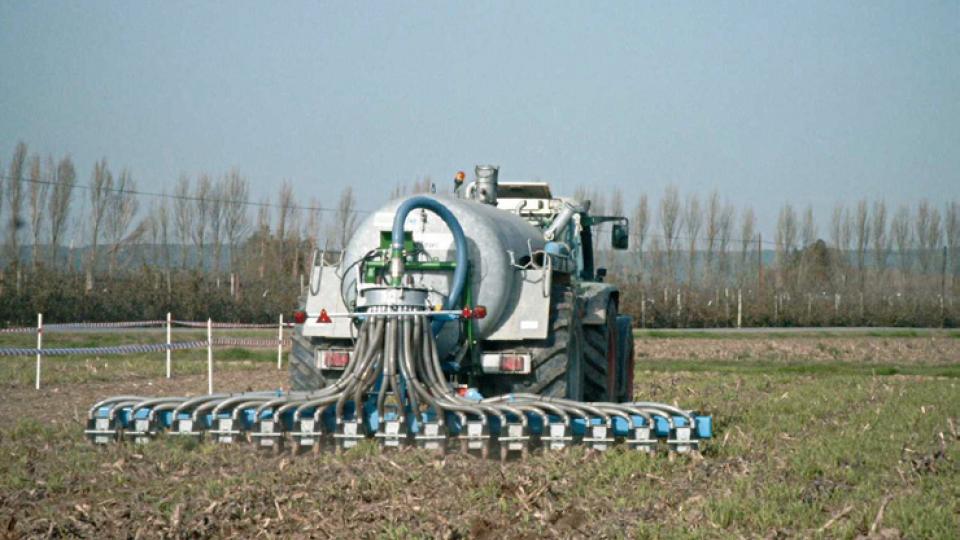
A slurry tank with an injection system.
A slurry tank with an injection system.
Photograph by Rosa Teira, 23 November 2003.
Click here to view Wikimedia source.
 This work is licensed under a Creative Commons Attribution-ShareAlike 3.0 Unported License.
This work is licensed under a Creative Commons Attribution-ShareAlike 3.0 Unported License.
The problem of ammonia pollution was nothing new. Several actors had already voiced strong opinions on the matter, such as Campo Galego, a well-known digital newspaper for agricultural information in Galicia, which was especially aggressive, denouncing the fact that, according to government data, ammonia emissions in Spain were still increasing in 2015. Other actors were critical of the way the state was managing the conflict. Indeed, as reported by Juan Castro, agronomist engineer, in 2015 Spain had exceeded by 34 percent its own national ceiling for ammonia emissions, as set out in European Directive 2001/81/EC. The problem accelerated when the EU threatened Spain with sanctions for violating environmental regulations, forcing the country to comply with EU environmental standards in order to receive CAP grants.
Conflict erupted when the most widespread newspaper in Galicia (La Voz de Galicia) reported on the issue, and the Galician agrarian unions—as reported by the trade unionist Javier Iglesias, of Unións Agrarias—claimed that it would be impossible to adopt the slurry injection system in Galicia due to the stony and mountainous terrain and frequent slopes. Local farmers themselves deplored the same problems, as stated by Mariano Pazos from the municipality of A Baña, a member of the peasants’ union Sindicato Labrego Galego. On another hand, the association of milk producers, in particular, launched protests against the government’s decision, as the requested technological change would have major implications for the future of the dairy sector in Galicia, which is the largest milk-producing region in Spain. Consequently, the issue was taken up by the autonomous government of Galicia (Xunta de Galicia), which tried to convince the Spanish central government to make exceptions, as the Galician agroecosystem with its rugged terrain was simply not suitable for the application of the injection system.
The Galician agrarian unions and the association of milk producers pointed to a number of different problems that could be caused by such a drastic technological change: if the injection system were adopted, the entire fleet of tractors in Galicia would have to be replaced by more powerful models, which would be completely unaffordable for farmers. They also indicated that the market supply of injection systems or hanging tubes for the application of slurry was insufficient. At the same time, they criticized the Spanish Department of Agriculture for their poor understanding of Galicia’s ammonia emissions problem, where, in fact, pig and other non-cattle farms had the highest pollution rates. As many such pig farms were also concentrated in other Spanish regions like Aragon and Catalonia in the northeast of Spain, Galician agricultural organizations hoped to lower the pressure on their region.
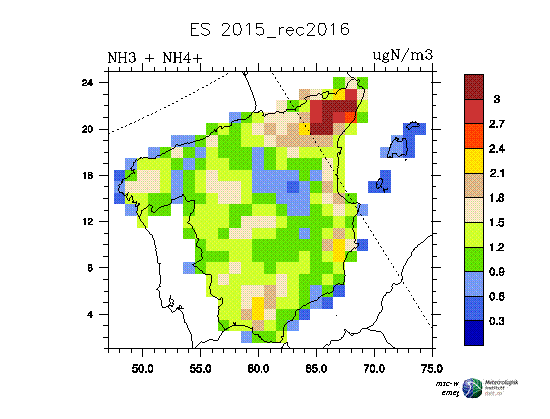
Ammonia emissions into the atmosphere in Spain (data from 2014). The highest-polluting areas are marked in red.
Ammonia emissions into the atmosphere in Spain (data from 2014). The highest-polluting areas are marked in red.
Graph by the Meteorological Synthesizing Centre-West of EMEP (MSC-W of EMEP), the Norwegian Meteorological Institute.
 This work is licensed under a Creative Commons Attribution 4.0 International License.
This work is licensed under a Creative Commons Attribution 4.0 International License.
Even though the conflict is still unresolved, it is possible to make some more general reflections on the risks and opportunities linked to the environmental sustainability paradigm in Spanish agriculture. Local and global, state and societal concerns often contradict each other. A careful understanding of local conditions is therefore required whenever political actors promote a new technological paradigm. The situation in Galicia demonstrates that technological change continues to provoke conflicts, and continues to benefit some social sectors and some regions to the detriment of others. If the massive introduction of tractors in the context of the Green Revolution paradigm caused deep, abrupt social and economic transformations that benefited some actors, they also damaged and excluded sectors of the peasantry in Galicia. Similarly, the technological change that is in line with European environmental policies won’t be socially neutral. The conflict in Galicia is a reminder that the environmental paradigm cannot be successfully implemented unless we understand its potentially disruptive effects on existing farming communities. Are we on the right track?
Acknowledgment
The author would like to thank Professor Katja Bruisch at Trinity College of Dublin for encouraging him to write this article.
How to cite
Esperante, Bruno. “Environmental Sustainability and Technological Change: The Slurry-Tanks Conflict in Galician Agriculture (1999–2019).” Environment & Society Portal, Arcadia (Spring 2019), no. 12. Rachel Carson Center for Environment and Society. doi.org/10.5282/rcc/8595.
ISSN 2199-3408
Environment & Society Portal, Arcadia
 This work is licensed under a Creative Commons Attribution 4.0 International License.
This work is licensed under a Creative Commons Attribution 4.0 International License.
2019 Bruno Esperante Paramos
This refers only to the text and does not include any image rights.
Please click on the images to view their individual rights status.
- Calatayud Giner, Salvador, Josep Puyol Andreu, and Juan Pan-Montojo. “Innovación y cambio técnico en la agricultura.” Revista de Historia Agraria, no. 27 (2002): 15–40.
- Castro Insua, Juan, et al. “As aplicacións web RAX de recomendacións de abonado con xurro nas pradeiras.” Afriga 22, no.126 (2017): 106–116 (link).
- Foladori, Guillermo. “Modernización ecológica, cambio tecnológico y globalización.” Economía, Sociedad y Territorio 5, no.18 (2005): 335–353. doi:10.22136/est002005308.
- Lanero, Daniel, and Dulce Freire. Agriculturas e innovación tecnológica en la Península Ibérica (1946–1975). Madrid: Ministerio de Medio Ambiente y Medio Rural y Marino, 2011.
- Soto, David. Historia dunha agricultural sustentábel. Transformacións produtivas na agricultura galega contemporánea. Santiago de Compostela: Xunta de Galicia, 2006.


